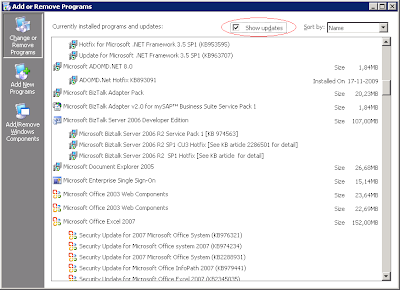| BizTalk Server 2006 R2 | 3.6.1404.0 | |
| BizTalk Server 2006 R2 SP1 | 3.6.2149.10 | January 27th, 2010 |
| Cumulative Update 1 (CU1) | 3.6.2210.12 | April 12th, 2010 |
| Cumulative Update 2 (CU2) | 3.6.2217.12 | June 24th, 2010 |
| Cumulative Update 3 (CU3) | 3.6.2224.12 | August 30th, 2010 |
For other Biztalk versions you can explore another Microsoft Link.
We made an update on Biztalk to CU3 and the version seen at About was still 3.6.2149.10, referring to the SP1.

To know the specific add-ons like CU's, and hotfixes, the only place to go is Add and Remove Programs. Just remember to mark the Show Updates. checkbox.

